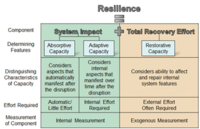-
Feds struggle to plug power grid security holes
Many of the current vulnerabilities in the power grid are attributable to newly adopted smart-grid technology, which allows operators to transmit energy from a diverse pool of resources. Smart-grid technology relies on devices in remote locations which constantly communicate with substations, those access points can be compromised by hackers.
-
-
A grid of the right size could reduce blackout risk
Scientists argue that for every animal there is an optimal size — one which allows it to make best use of its environment and the physical laws that govern its activities, whether hiding, hunting, hoofing, or hibernating. Now, researchers are asking whether there is a “right” size for another type of huge beast: the U.S. power grid. The researchers believe that smaller grids would reduce the likelihood of severe outages, such as the 2003 Northeast blackout that cut power to fifty million people in the United States and Canada for up to two days.
-
-
Debate over closing NY’s Indian Point nuclear power plant intensifies
Indian Pointnuclear power plant, just thirty miles from New York City, has presented a conundrum for environmentalists who advocate clean-air initiatives, caps on carbon emissions, and increasing investment in non-polluting renewable energy sources — but at the same time argue that nuclear power poses a safety hazard to the surrounding area and demand that Indian Point cease operations. Closing the plant would require a long-term energy strategy to replace the 2,000 megawatts the plant currently produces.
-
-
Chemical plant security measure moves forward in the House
The House Homeland Security Committee and the House Energy and Commerce Committee are making progress on legislation meant to extend DHS’s Chemical Facility Anti-Terrorism Standardsprogram, which helps secure commercial chemical plants from terrorist attacks. Several attempts by the House Homeland Security Committee to extend the program have failed due to disagreements with the House Energy and Commerce Committee, which also oversees the matter.
-
-
Scale model WWII-era plane flies with fuel from the sea

U.S. Navy researchers demonstrated proof-of-concept of novel technologies developed for the recovery of carbon dioxide (CO2) and hydrogen (H2) from seawater and conversion to a liquid hydrocarbon fuel. Fueled by a liquid hydrocarbon — a component of NRL’s novel gas-to-liquid (GTL) process which uses CO2 and H2 as feedstock — the research team demonstrated sustained flight of a radio-controlled (RC) P-51 replica of the legendary Red Tail Squadron, powered by an off-the-shelf (OTS) and unmodified two-stroke internal combustion engine.
-
-
Alternative strategy for uranium processing at Oak Ridge
A group of twenty-five experts referred to as the Red Team, assigned to review alternatives to the Uranium Processing Facility (UPF) at Oak Ridge National Laboratory, have reached a “strong consensus” on what could be an alternative strategy, but will spend the next two weeks polishing their work before presenting it to National Nuclear Security Administration (NNSA). Red Team was instructed to design a way to move uranium processing from Building 9212, Y-12’s Second World War-era center for processing highly enriched uranium, by 2025 and at under $6.5 billion.
-
-
New group formed to monitor Savannah River Site, nuclear waste issues in SE U.S.
Savannah River Site Watch (SRS Watch), a new public-interest watchdog group, was launched last week in what it said was a response to the need for increased monitoring of the nuclear projects carried out by the U.S. Department of Energy (DOE). The group says it has been formed to focus on an array of nuclear projects now underway at Savannah River Site (SRS), the sprawling 310-square mile complex located near Aiken, South Carolina.
-
-
Bangladesh tops list of countries at risk from sea level rise
Scientists say that see levels may rise by up to the feet by 2100.The implications of this would have drastic consequences for nearly all coastal nations, but the consensus is that Bangladesh will be the hardest hit by the change. Leading Bangladeshis say that since Bangladesh produces less than 0.3 percent of the emissions driving climate change, it would unjust for Bangladesh to rely on its own meager resources to solve this problem. One solution they offer: fifty million Bangladeshis (out of a population of 163 million) should be allowed to move to and resettle in the countries which produce the bulk of greenhouse gasses.
-
-
More stringent climate policies mean hard choices for coal plant operators
Limiting climate change to 2°C means shutting down coal power plants — an unpopular proposition for coal power companies. A new study shows, however, that delaying climate policies could prove even worse for power plant owners. The reason: new power plants being built now, especially in China and India, are built to run for 30-50 years, paying off only after years of operation. Stringent climate policies, however, could make the cost of emission so high that coal power generation is no longer competitive, leaving new power plants sitting idle and their owners and investors with huge losses — a problem known as stranded capacity.
-
-
Coalition sounds alarm about possible global EMP disaster
A coalition that includes former speaker of the House Newt Gingrich and former CIA director James Woolsey has issued a terse warning regarding apocalyptic effects that could result from a mass EMP (electromagnetic pulse) disaster or attack. Members of the coalition “are convinced that our fragile electrical grid could be wiped out at any moment” from bursts of electrical energy caused by anything from a nuclear explosion to a solar flare from the sun, leading to chaos on a global scale.
-
-
Los Alamos National Lab resumes transuranic waste shipments

The waste was received at Waste Control Specialists in Andrews, Texas, where it will be temporarily staged until it can be shipped to the Waste Isolation Pilot Plant (WIPP) near Carlsbad, New Mexico for final disposal. WIPP has been closed since mid-February as a result of radiation leaks in underground storage tunnels. The shipments keep LANL on track to complete 3,706 Campaign on schedule. The campaign aims to remove 3,706 cubic meters of nuclear waste from LANL by 30 June 2014.
-
-
Capabilities-based – rather than actuarial -- risk analysis would make businesses safer
Many businesses and organizations, when applying cost-benefit analysis and a risk-management analysis to measure cyber risk, are relying on the assumption that the likelihood of a future attack depends heavily on how many attacks have occurred in the past. Since there has yet to be a full-scale attack on critical infrastructure in the United States, it is simple to conclude that the risk of a cyberattack on critical infrastructure is low, therefore justifying low investment in additional security initiatives. An actuarial risk analysis may conclude that there is little likelihood of such as attack occurring, but a capabilities-based risk analysis recognizes that since adversaries are capable of such an attack, it is in an organization’s best interest to secure against it.
-
-
W.Va. residents still wary about their drinking water
The January 2014 chemical spill in West Virginia, which contaminated the drinking water of 300,000 residents, has changed how residents use public water. Authorities claimed the water was safe for consumption on 13 January, since MCHM levels had dropped below a federal safety threshold of one part per million. Residents remain skeptical, with some collecting rain water, and other relying on clean water distributed by non-profits.
-
-
New center will work to improve methods to detect, prevent the spread of nuclear weapons
The National Nuclear Security Administration (NNSA) has awarded the University of Michigan $25 million to establish the Center for Verification Technology. A team from thirteen universities will work with eight national labs to analyze nuclear nonproliferation efforts, improve technologies for monitoring weapons-grade materials and detecting secret weapon tests, and train the next generation of nonproliferation experts.
-
-
Sandia to help cities be better prepared for, emerge stronger from, disasters

Sandia National Laboratories says it will bring its experience solving problems with practical engineering and modeling complex systems to cities around the world under a new agreement to support the 100 Resilient Cities Centennial Challenge, pioneered by the Rockefeller Foundation. The challenge, which will help thirty-three cities in its first year, seeks to make communities more resilient by being better prepared to withstand natural or manmade disasters, recover more quickly, and emerge stronger.
-
More headlines
The long view
Helping Strengthen America’s Critical Infrastructure
Everyday life depends on a robust infrastructure network that provides access to running water, communications technology and electricity, among other basic necessities. The experts who keep our national infrastructure secure and resilient also need a strong network to share their knowledge and train the next generation of professionals capable of solving complex infrastructure challenges.
AI and the Future of the U.S. Electric Grid
Despite its age, the U.S. electric grid remains one of the great workhorses of modern life. Whether it can maintain that performance over the next few years may determine how well the U.S. competes in an AI-driven world.
Using Liquid Air for Grid-Scale Energy Storage
New research finds liquid air energy storage could be the lowest-cost option for ensuring a continuous power supply on a future grid dominated by carbon-free but intermittent sources of electricity.
Enhanced Geothermal Systems: A Promising Source of Round-the-Clock Energy
With its capacity to provide 24/7 power, many are warming up to the prospect of geothermal energy. Scientists are currently working to advance human-made reservoirs in Earth’s deep subsurface to stimulate the activity that exists within natural geothermal systems.
Experts Discuss Geothermal Potential
Geothermal energy harnesses the heat from within Earth—the term comes from the Greek words geo (earth) and therme (heat). It is an energy source that has the potential to power all our energy needs for billions of years.
